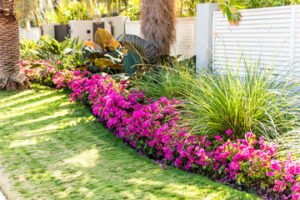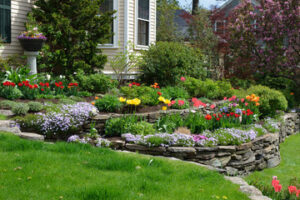Landscaping is the addition of woody ornamental or edible plants, changes to the terrain and construction of structures like fences. It also includes water and lighting features.

A good landscape design takes into consideration form, light, balance, contrast, variety and harmony. The first step is to understand the site conditions. Contact Greensboro Landscaping for specialized services.
A beautiful, functional landscape can be a source of pride and pleasure for homeowners. It can also increase the value of a home by decreasing its time on the market and reducing maintenance costs. Proper landscaping can also save energy by limiting the need for air conditioning in summer and heat loss during winter. It can also block noise and undesirable views.
Plants have three major roles in a landscape: aesthetic, structural and utilitarian. Aesthetically, plants provide color, texture and visual interest to a landscape. Structurally, they organize and define spaces. Functionally, they protect and improve the condition of the soil, control erosion, absorb water, reduce wind, filter odors and help retain humidity.
Landscape professionals use the physical characteristics of plants to create their design ideas. These include size, shape, form, and color. Physical attributes are important because they give a plant its unique appearance and personality. Some plants are extroverts, while others are quiet and calm. A good mix of personalities helps create a harmonious and appealing garden.
The color and texture of flowers, foliage, fruit, stems/branches and bark add dimension and beauty to a landscape. These characteristics vary by season. They can be used in unity to convey an overall look, or in contrast to create depth and separate different areas of a landscape. Plants can also affect the temperature of a space, influence rainfall and help reduce erosion.
Landscaping is an ongoing process that requires a commitment of time and resources. It is crucial to work with experienced and knowledgeable landscaping professionals. A poorly planned and executed project can be expensive, causing delays and frustrating the client.
Native plants are those that occur naturally in a specific region. They have co-evolved with native insects, birds and other wildlife. They provide essential food, shelter, and nesting materials for wildlife. Native plants are also the ecological foundation upon which natural habitats depend. By introducing native plants into the landscape, we can preserve and celebrate our cultural heritage and contribute to a healthy ecosystem.
Hardscapes
Unlike softscapes, hardscapes are non-living and consist of non-plant elements like walkways, patios, and retaining walls. The term “hardscape” is often misinterpreted to refer solely to concrete or other types of man-made materials used in landscaping, but it encompasses all aspects of outdoor design that do not contain living organic material. Gravel, a brick walkway, and even a decorative fountain are all examples of hardscapes.
Adding hardscapes to your residential landscape offers numerous benefits. Aside from adding structure and definition to your property, it increases usable outdoor space for entertaining, relaxing, cooking, or simply enjoying the weather. Additionally, hardscapes increase the value of your home. Many buyers look for patios, fire pits, and outdoor kitchens when searching for a new house.
With so many options for hardscapes, it is important to choose the materials that are right for your unique needs and taste. There are a number of factors to consider, including durability, cost, and maintenance. Pavers, for example, are an affordable and durable option that blends well with most landscaping designs. Additionally, they come in a range of colors and textures to suit your aesthetic preferences.
Another benefit of hardscapes is that they require less maintenance than plants and grass. Once installed, pavers, stone, and brick are resistant to damage from storms and heavy traffic, reducing the need for constant repairs or replacement. In addition, replacing your lawn with pavers or other hardscapes can cut down on water consumption and eliminate the need for chemical fertilizers and pesticides.
Hardscapes are also a great way to add dimension and contrast to your commercial landscape. For example, a retaining wall can prevent erosion while a waterfall or fountain can create a visual focal point for your business’s exterior. Additionally, hardscapes can protect the organic parts of your property by redirecting rainwater away from areas where it is not wanted and toward those that do need it.
While softscaping is crucial to any landscape, hardscapes provide a necessary framework and infrastructure that complements and enhances the natural environment. By using a combination of stone, brick, and concrete, you can build walkways, define garden beds, and create structures for seating, dining, or relaxation.
Water
A landscape designed with proper water management practices can help to prevent erosion, reduce stormwater runoff, and promote the growth of native plants. These factors are important in preventing pollution from making its way into local lakes, rivers and streams. Landscaping can also be used to provide natural areas for wildlife habitat.
When it comes to conserving and preserving our natural resources, water is top of mind for many of us. The practice of water-wise landscaping, sometimes referred to as “xeriscaping” or “zero maintenance” landscapes, helps save precious drinking and irrigation water. It can be achieved by using plants that are adapted to your local climate, minimizing water usage, installing efficient irrigation systems, and incorporating hardscaping elements into your yard that require little to no irrigation.
The benefits of xeriscaping include reducing the need for irrigation, saving time and money on maintenance, promoting the use of native plant species, and reducing environmental impacts. It can also reduce the need for pesticides and fertilizers, which are often harmful to the environment. A well-designed xeriscaping landscape can save enough energy to pay for itself in just eight years through savings on air conditioning costs and heating bills.
Besides saving water, xeriscaping can enhance your property value and increase its visual appeal. The landscape design can create an inviting space where you and your family and friends will enjoy spending time. Research shows that people who spend time in nature experience reduced stress, anxiety and depression. This can be due to the calming effects of trees and other vegetation, or from the release of endorphins. The right landscape design can help you feel at ease in your own backyard.
EVMWD has partnered with a local professional landscape architect to offer free xeriscaping landscape designs that can replace your lawn with a beautiful, low maintenance water wise garden. You can find these designs under the Landscaping with Style section. Additionally, EVMWD offers rebates for efficient irrigation equipment such as smart irrigation controllers and drip systems. Learn more at the Rebates page.
Lighting
Your home’s landscaping is a major investment, so why let it disappear once the sun goes down? With proper landscape lighting, your yard and house can be a nighttime showcase. Landscape lighting offers a variety of benefits, from safety to ambiance.
Illuminating your home and its landscaping shows that you’re proud of your property, and it’s a great way to show off to guests. Adding landscape lighting also increases the value of your home. A study conducted by the National Association of Home Builders found that potential buyers rated outdoor lighting as one of the top desirable features.
There are a variety of different landscape lighting techniques to choose from, and a professional can help you decide what’s right for your yard. Highlighting is a popular technique that draws attention to specific features, such as trees or statues. Silhouetting, on the other hand, involves positioning a light behind an object to create a dramatic silhouette effect.
You can use lighting to illuminate paths, stairs, and other safety hazards around your property. Not only does this make it easier to navigate your yard after dark, but it can deter criminals and other unwanted intruders from coming onto your property.
Landscape lighting can also highlight a variety of other decorative elements on your property, such as your driveway, water features, or flower beds. It can even draw attention to the architecture of your home and other architectural features on the property, such as your deck or gazebo.
Before installing any landscape lights, you should map out the layout of your property and the features you want to highlight. Then, you can select the best fixtures for each area. For example, you should place downlights higher up in the trees to illuminate a lawn or path below, while wash lights are designed to illuminate large areas with a broad beam. Flood lights are brighter and can be used to illuminate a wide range of spaces, such as tall trees or a large home facade.
Lastly, it’s important to choose the right bulbs for your landscape lights. LED bulbs are a great choice for landscape lighting because they last longer and consume less energy than halogen bulbs. Additionally, they produce a lower amount of heat than halogen bulbs, which can damage delicate plants.
